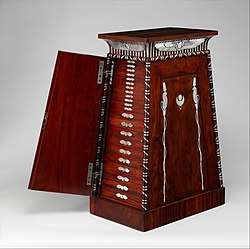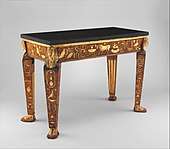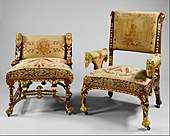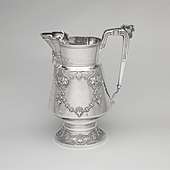Egyptian Revival decorative arts
Egyptian revival decorative arts is a style in Western art, mainly of the early nineteenth century, in which Egyptian motifs were applied to a wide variety of decorative arts objects.

Enthusiasm for the artistic style of Ancient Egypt is generally attributed to the excitement over Napoleon's conquest of Egypt and, in Britain, to Admiral Nelson's defeat of Napoleon at the Battle of the Nile in 1798. Napoleon took a scientific expedition with him to Egypt. Publication of the expedition's work, the Description de l'Égypte, began in 1809 and came out in a series though 1826, inspiring everything from sofas with Sphinxes for legs, to tea sets painted with the pyramids. It was the popularity of the style that was new, Egyptianizing works of art had appeared in scattered European settings from the time of the Renaissance.
The Egyptian Gallery, a private room in the Duchess Street home of connoisseur Thomas Hope to display his Egyptian antiquities, and illustrated in engravings from his meticulous line drawings in his book, Household Furniture and Interior Decoration (1807), were a prime source for the Regency style in British furnishings. The book inspired a generation of fashionable English homeowners to install parlor suites featuring chairs, tables and sofas in shapes that evoked the objects depicted on Egyptian tomb paintings.[1][2]
Later discoveries prompted small further revivals.
Gallery
 Table with lion heads, in the Château de Valençay (Valençay, France)
Table with lion heads, in the Château de Valençay (Valençay, France) Table; 1775-1780; wood, carved, painted, and partly gilded, and black granite top not original to table; 89.9 x 123.5 x 58.4 cm; Metropolitan Museum of Art (New York City)
Table; 1775-1780; wood, carved, painted, and partly gilded, and black granite top not original to table; 89.9 x 123.5 x 58.4 cm; Metropolitan Museum of Art (New York City)_MET_DP-13032-007.jpg) Pair of British six-light candelabrums with stands; 1802-1806; gilt bronze; wight of a candelabrum: 19.1 kg; Metropolitan Museum of Art
Pair of British six-light candelabrums with stands; 1802-1806; gilt bronze; wight of a candelabrum: 19.1 kg; Metropolitan Museum of Art Armchair; 1870-1875; rosewood and prickly juniper veneer; 94 x 69.9 x 69.9 cm; Metropolitan Museum of Art
Armchair; 1870-1875; rosewood and prickly juniper veneer; 94 x 69.9 x 69.9 cm; Metropolitan Museum of Art.jpg) Center table; 1870-1875; rosewood, walnut and marble; 79.4 x 119.4 x 78.7 cm; Metropolitan Museum of Art
Center table; 1870-1875; rosewood, walnut and marble; 79.4 x 119.4 x 78.7 cm; Metropolitan Museum of Art'_MET_DP830845.jpg) Bed from 'Nouveaux modèles de Tentures (Bibliothèque de l'Ameublement)'; 1775-1780; color lithography; dimensions of the sheet: 47 × 32.8 cm, dimensions of the image: 33 × 22.5 cm; Metropolitan Museum of Art
Bed from 'Nouveaux modèles de Tentures (Bibliothèque de l'Ameublement)'; 1775-1780; color lithography; dimensions of the sheet: 47 × 32.8 cm, dimensions of the image: 33 × 22.5 cm; Metropolitan Museum of Art Obelisk clock with a Franklin movement; circa 1785-1790; oak, thuya burl wood, gilded bronze, silver, and steel; overall: 190.5 × 53.7 × 19.3 cm; Metropolitan Museum of Art
Obelisk clock with a Franklin movement; circa 1785-1790; oak, thuya burl wood, gilded bronze, silver, and steel; overall: 190.5 × 53.7 × 19.3 cm; Metropolitan Museum of Art Pitcher; circa 1872; silver; overall: 28.6 x 15.6 x 21.9 cm; Metropolitan Museum of Art
Pitcher; circa 1872; silver; overall: 28.6 x 15.6 x 21.9 cm; Metropolitan Museum of Art Egyptian Revival clock; by Tiffany & Co.; circa 1885; marble & bronze; 46 x 51.1 x 19.7 cm; Metropolitan Museum of Art
Egyptian Revival clock; by Tiffany & Co.; circa 1885; marble & bronze; 46 x 51.1 x 19.7 cm; Metropolitan Museum of Art Necklace with scarabs; by Giacinto Melillo; late 19th-early 20th century; gold, steatite and lapis lazuli; length: 36.8 cm; Walters Art Museum (Baltimore, USA)
Necklace with scarabs; by Giacinto Melillo; late 19th-early 20th century; gold, steatite and lapis lazuli; length: 36.8 cm; Walters Art Museum (Baltimore, USA)
Sources
- Egyptomania; Egypt in Western Art; 1730–1930, Jean-marcel Humbert, Michael Pantazzi and Christiane Ziegler, 1994
- The Egyptian revival : its sources, monuments, and meaning, 1808–1858, Richard G. Carrott, 1978
- The Egyptian Revival: Ancient Egypt as the Inspiration for Design Motifs in the West, James Stevens Curl, 2005
- Household Furniture and Interior Decoration, Thomas Hope, 1807
References
External links
| Wikimedia Commons has media related to Egyptian Revival applied arts. |